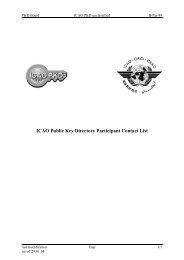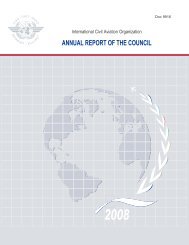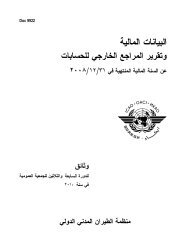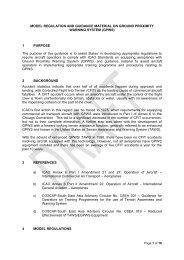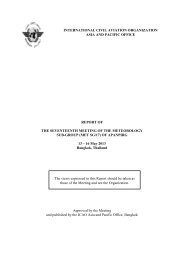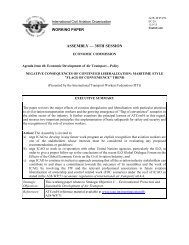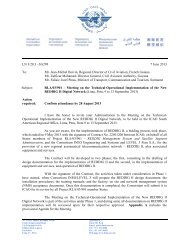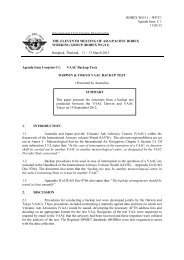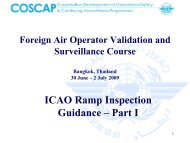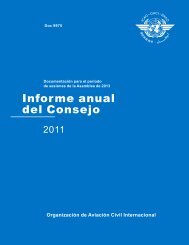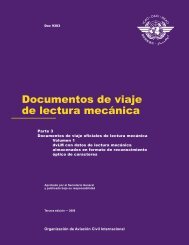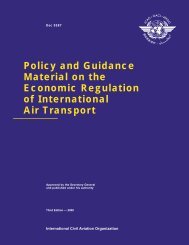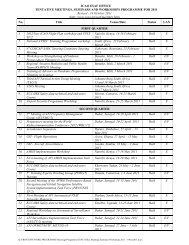afi met bulletins exchange (ambex) handbook - ICAO
afi met bulletins exchange (ambex) handbook - ICAO
afi met bulletins exchange (ambex) handbook - ICAO
Create successful ePaper yourself
Turn your PDF publications into a flip-book with our unique Google optimized e-Paper software.
Page 11 of 29<br />
Volcanic Ash Contingency Plan – AFI Region<br />
ATTACHMENT A - GENERAL GUIDANCE FOR THE DEVELOPMENT OF ATM CONTINGENCY<br />
PLANS FOR VOLCANIC ASH 4<br />
(This information is adapted from the Manual on Volcanic Ash, Radioactive Material and Toxic Chemical Clouds (Doc<br />
9691). Refer to this document for full details.)<br />
1. In a contingency plan relating to volcanic contamination certain steps need to be taken to provide a coordinated<br />
and controlled response for dealing with an event of this nature. Responsibilities should be clearly defined for the<br />
manager in charge, supervisors and air traffic controllers (ATCOs). The plan should also identify the officials who need<br />
to be contacted, the type of messages that are to be created, the proper distribution of the messages and how to conduct<br />
business.<br />
2. ATCOs need to be trained and be made aware of the potential effects if aircraft encounter unsafe levels of<br />
volcanic ash.<br />
3. Some particular points of guidance are as follows:<br />
a) volcanic ash contamination may extend for hundreds of miles horizontally and reach the stratosphere<br />
vertically;<br />
b) volcanic ash may block the pitot-static system of an aircraft, resulting in unreliable airspeed indications;<br />
c) braking conditions at airports where volcanic ash has recently been deposited on the runway will affect<br />
the braking ability of the aircraft. This is more pronounced on runways contaminated with wet ash.<br />
Pilots and ATCOs should be aware of the consequences of volcanic ash being ingested into the engines<br />
during landing and taxiing. For departure it is recommended that pilots avoid operating in visible<br />
airborne ash; instead they should allow sufficient time for the particles to settle before initiating a takeoff<br />
roll, in order to avoid ingestion of ash particles into the engine. In addition, the movement area to<br />
be used should be carefully swept before any engine is started;<br />
d) volcanic ash may result in the failure or power loss of one or all engines of an aeroplane; and<br />
e) airports might have to be declared unsafe for flight operations. This might have consequences for the<br />
ATM system.<br />
4. The area control centre (ACC) in conjunction with air traffic flow management (ATFM) units serves as the<br />
critical communication link between affected aircraft in flight and the information providers during a volcanic eruption.<br />
During episodes of volcanic contamination within the FIR, the ACC has two major communication roles. First and of<br />
greatest importance is its ability to communicate directly with aircraft en route which may encounter the ash. Based on<br />
the information provided in the volcanic ash SIGMET and volcanic ash advisories (VAAs) and working with<br />
<strong>met</strong>eorological watch offices (MWOs), the ATCOs should be able to advise the pilot of which flight levels are affected<br />
by the ash and the projected trajectory and drift of the contamination. Through the use of radio communication, ACCs<br />
have the capability to coordinate with the pilot alternative routes which would keep the aircraft away from the volcanic<br />
ash.<br />
5. Similarly, through the origination of a NOTAM/ASHTAM for volcanic activity the ACC can disseminate<br />
information on the status and activity of a volcano even for pre-eruption increases in volcanic activity.<br />
NOTAM/ASHTAM and SIGMET together with AIREPs are critical to dispatchers for flight planning purposes.<br />
Operators need as much advance notification as possible on the status of a volcano for strategic planning of flights and<br />
the safety of the flying public. Dispatchers need to be in communication with pilots en route so that a coordinated<br />
decision can be made between the pilot, the dispatcher and ATS regarding alternative routes that are available. It cannot<br />
be presumed, however, that an aircraft which is projected to encounter ash will be provided with the most desirable<br />
4<br />
This information is adapted from the Manual on Volcanic Ash, Radioactive Material and Toxic Chemical Clouds (Doc 9691).<br />
Refer to this document for full details.



